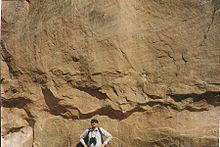Type Geological formation Underlies Batoka Formation | Overlies Pebbly Arkose Formation | |
 | ||
Country Botswana, Zambia, Zimbabwe Named for Forests of Nyamandlovu District, Zimbabwe Named by A.M. MacGregor, Zimbabwe Geological Survey Unit of Upper Karoo Group, Karoo Supergroup | ||
The Forest Sandstone Formation is a geological formation in southern Africa, dating to roughly between 200 to 190 million years ago and covering the Hettangian to Sinemurian stages of the Jurassic Period in the Mesozoic Era. As its name suggests, it consists mainly of sandstone.
Contents
Fossils of the prosauropod dinosaur Massospondylus have been recovered from the Forest Sandstone.
Description
The formation is a sedimentary unit, consisting mainly of aeolian sands and silts with interbedded fluvial sediments, laid down during a period of increasing aridity.
Extent
The Forest Sandstone Formation is found in Botswana, Zambia, Zimbabwe, in the Mid-Zambezi, Mana Pools, Cabora Bassa and Limpopo basins with its greatest thickeness in the Cabora Bassa Basin.
Age
The formation is dated at 200 to 190 Ma.
Stratigraphy
The Forest Sandstone is the penultimate formation in the Upper Karoo Group of the Karoo Supergroup, lying above the Pebbly Arkose Formation and below the Batoka Formation. In the Thuli Basin it is sometimes referred to as the Samkoto Formation.
The Forest Sandstone has been correlated to the Clarens Formation of the Great Karroo Basin, South Africa.
Hydrogeology
The Forest Sandstone is the major groundwater-bearing unit of the Upper Karoo Group.
